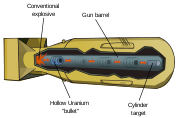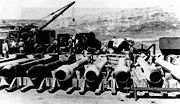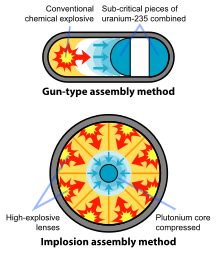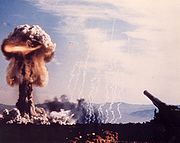
Gun-type fission weapon
Encyclopedia

Nuclear fission
In nuclear physics and nuclear chemistry, nuclear fission is a nuclear reaction in which the nucleus of an atom splits into smaller parts , often producing free neutrons and photons , and releasing a tremendous amount of energy...
-based nuclear weapons whose design
Nuclear weapon design
Nuclear weapon designs are physical, chemical, and engineering arrangements that cause the physics package of a nuclear weapon to detonate. There are three basic design types...
assembles their fissile material into a supercritical mass by the use of the "gun" method: shooting one piece of sub-critical material into another. Although this is sometimes pictured as two sub-critical hemispheres driven together to make a supercritical sphere, typically a hollow projectile is shot onto a spike which fills the hole in its center. Its name is a reference to the fact that it is shooting the material through an artillery
Artillery
Originally applied to any group of infantry primarily armed with projectile weapons, artillery has over time become limited in meaning to refer only to those engines of war that operate by projection of munitions far beyond the range of effect of personal weapons...
barrel as if it were a projectile. Other potential arrangements may include firing two pieces into each other simultaneously, though whether this approach has been used in actual weapons designs is unknown.
Since it is a relatively slow method of assembly, plutonium
Plutonium
Plutonium is a transuranic radioactive chemical element with the chemical symbol Pu and atomic number 94. It is an actinide metal of silvery-gray appearance that tarnishes when exposed to air, forming a dull coating when oxidized. The element normally exhibits six allotropes and four oxidation...
cannot be used practically (see below). The required amount of uranium
Uranium
Uranium is a silvery-white metallic chemical element in the actinide series of the periodic table, with atomic number 92. It is assigned the chemical symbol U. A uranium atom has 92 protons and 92 electrons, of which 6 are valence electrons...
is relatively large, and the efficiency relatively low.
The method was applied in four known programs. First, the "Little Boy
Little Boy
"Little Boy" was the codename of the atomic bomb dropped on Hiroshima on August 6, 1945 by the Boeing B-29 Superfortress Enola Gay, piloted by Colonel Paul Tibbets of the 393rd Bombardment Squadron, Heavy, of the United States Army Air Forces. It was the first atomic bomb to be used as a weapon...
" weapon which was detonated over Hiroshima
Hiroshima
is the capital of Hiroshima Prefecture, and the largest city in the Chūgoku region of western Honshu, the largest island of Japan. It became best known as the first city in history to be destroyed by a nuclear weapon when the United States Army Air Forces dropped an atomic bomb on it at 8:15 A.M...
and several additional units of the same design prepared after World War 2, in 40 Mark 8
Mark 8 nuclear bomb
The Mark 8 nuclear bomb was a nuclear bomb designed late 1940s and early 1950s, which was in service from 1952 to 1957.- Description :The Mark 8 was a gun type nuclear bomb, which rapidly assembles several critical masses of fissile nuclear material by firing a fissile projectile or "bullet" into a...
bombs, and their replacement, 40 Mark 11
Mark 11 nuclear bomb
The Mark 11 nuclear bomb was an American nuclear bomb developed from the earlier Mark 8 nuclear bomb in the mid 1950s. Like the Mark 8, the Mark 11 was an earth-penetrating weapon, also known as a Nuclear bunker buster bomb.- Description :...
bombs. The second was a family of 11 inch nuclear artillery
Nuclear artillery
Nuclear artillery is a subset of limited-yield tactical nuclear weapons, in particular those weapons that are launched from the ground at battlefield targets...
shells, the W9
W9 (nuclear warhead)
The W9 was an American nuclear artillery shell fired from a special 11 inch howitzer. It was produced starting in 1952 and all were retired by 1957.-Description:...
and its derivative W19, plus a repackaged W19 in a 16 inch shell for US Navy battleships, the W23. The third family was an 8 inch artillery shell, the W33. Last, South Africa
South Africa
The Republic of South Africa is a country in southern Africa. Located at the southern tip of Africa, it is divided into nine provinces, with of coastline on the Atlantic and Indian oceans...
also developed a handful (8) of nuclear bombs based on the gun-type principle, and was working on missile warheads using the same basic design - See South Africa and weapons of mass destruction#Nuclear weapons.
There are currently no known gun-type weapons in service: advanced nuclear weapon states tended to abandon the design in favor of the implosion type weapon, and new nuclear weapon states tend to develop implosion-type weapons only. All known gun-type nuclear weapons previously built worldwide have been dismantled by this time.
Little Boy
.png)
Hiroshima
is the capital of Hiroshima Prefecture, and the largest city in the Chūgoku region of western Honshu, the largest island of Japan. It became best known as the first city in history to be destroyed by a nuclear weapon when the United States Army Air Forces dropped an atomic bomb on it at 8:15 A.M...
, worked, using uranium-235
Uranium-235
- References :* .* DOE Fundamentals handbook: Nuclear Physics and Reactor theory , .* A piece of U-235 the size of a grain of rice can produce energy equal to that contained in three tons of coal or fourteen barrels of oil. -External links:* * * one of the earliest articles on U-235 for the...
as its enriched material. In the Little Boy design, the U-235 "bullet" had a mass of around 86 pounds (39 kg), and it was 7 inches (17.8 cm) long, with a diameter of 6.25 inches (15.9 cm). The hollow cylindrical shape made it subcritical. It was powered by a cordite
Cordite
Cordite is a family of smokeless propellants developed and produced in the United Kingdom from 1889 to replace gunpowder as a military propellant. Like gunpowder, cordite is classified as a low explosive because of its slow burning rates and consequently low brisance...
charge. The uranium target spike was about 57.3 pounds (26 kg). Both the bullet and the target consisted of multiple rings stacked together.
The use of "rings" had two advantages: it allowed the larger bullet to confidently remain subcritical (the hollow column served to keep the material from having too much contact with other material), and it allowed sub-critical assemblies to be tested using the same bullet but with just one ring.
The barrel had an inside diameter of 6.5 inches (16.5 cm). Its length was 70.8 inches (1.8 m), which allowed the bullet to accelerate to its final speed of 984 feet per second (300 m/s) before coming into contact with the target.
When the bullet is at a distance of 9.8 inches (25 cm), the combination becomes critical. This means that some free neutrons may cause the chain reaction to take place before the material could be fully joined (see nuclear chain reaction
Nuclear chain reaction
A nuclear chain reaction occurs when one nuclear reaction causes an average of one or more nuclear reactions, thus leading to a self-propagating number of these reactions. The specific nuclear reaction may be the fission of heavy isotopes or the fusion of light isotopes...
).
Note that typically the chain reaction takes less than 1 μs (100 shake
Shake (time)
A shake is an informal unit of time equal to 10 nanoseconds, or 10−8 seconds. It has applications in nuclear physics, helping to conveniently express the timing of various events in a nuclear explosion. The typical time required for one step in the chain reaction A shake is an informal unit of time...
s), during which time the bullet travels only 0.3 mm. Although the chain reaction is slower when the supercriticality is low, it still happens in a time so short that the bullet hardly moves in that time.
This could cause a fizzle, a predetonation which would blow the material apart before creating much of an explosion. Thus it is important that the frequency at which free neutrons occur is kept low, compared with the assembly time from this point. This also means that the speed of the projectile must be sufficiently high; its speed can be increased but this requires a longer and heavier barrel.
In the case of Little Boy, the 20% U-238
Uranium-238
Uranium-238 is the most common isotope of uranium found in nature. It is not fissile, but is a fertile material: it can capture a slow neutron and after two beta decays become fissile plutonium-239...
in the uranium had 70 spontaneous fission
Spontaneous fission
Spontaneous fission is a form of radioactive decay characteristic of very heavy isotopes. Because the nuclear binding energy reaches a maximum at a nuclear mass greater than about 60 atomic mass units , spontaneous breakdown into smaller nuclei and single particles becomes possible at heavier masses...
s per second. With the fissional material in a supercritical state, each gave a large probability of detonation: each fission creates on average 2.52 neutrons, which each have a probability of more than 1:2.52 of creating another fission. During the 1.35 ms of supercriticality prior to full assembly, there was a 10% probability of a fission, with somewhat less probability of pre-detonation.


Plutonium
Plutonium is a transuranic radioactive chemical element with the chemical symbol Pu and atomic number 94. It is an actinide metal of silvery-gray appearance that tarnishes when exposed to air, forming a dull coating when oxidized. The element normally exhibits six allotropes and four oxidation...
as its source of fissile material, known as the "Thin Man
Thin Man nuclear bomb
The "Thin Man" nuclear bomb was a proposed plutonium gun-type nuclear bomb which the United States was developing during the Manhattan Project...
" because of its extreme length. It was thought that if a plutonium gun-type bomb could be created, then the uranium gun-type bomb would be very easy to make by comparison. However, it was discovered in April 1944 that reactor
Nuclear reactor
A nuclear reactor is a device to initiate and control a sustained nuclear chain reaction. Most commonly they are used for generating electricity and for the propulsion of ships. Usually heat from nuclear fission is passed to a working fluid , which runs through turbines that power either ship's...
-bred plutonium (Pu-239) is contaminated with another isotope of plutonium, Pu-240, which increases the material's spontaneous neutron-release rate, making pre-detonation inevitable. For this reason, a gun-type bomb is thought to only be usable with an enriched-uranium bomb.
After it was discovered that the "Thin Man" program would not be successful, Los Alamos redirected its efforts into creating the implosion-type plutonium weapon: "Fat Man
Fat Man
"Fat Man" is the codename for the atomic bomb that was detonated over Nagasaki, Japan, by the United States on August 9, 1945. It was the second of the only two nuclear weapons to be used in warfare to date , and its detonation caused the third man-made nuclear explosion. The name also refers more...
". The gun program switched completely over to developing a uranium bomb.
Although in Little Boy 132 pounds (60 kg) of 80%-grade U-235 was used (hence 106 pounds (48 kg)), the minimum is ca. 44 to 55 pounds (20 to 25 kg), versus 33 pounds (15 kg) for the implosion method.
The scientists who designed the "Little Boy" weapon were confident enough of its likely success that they did not field-test a design before using it in war (though they
Louis Slotin
Louis Alexander Slotin was a Canadian physicist and chemist who took part in the Manhattan Project, the secret US program during World War II that developed the atomic bomb....
did perform non-destructive tests with sub-critical assemblies, as part of their experiments—known as tickling the dragon's tail
Criticality accident
A criticality accident, sometimes referred to as an excursion or a power excursion, is an accidental increase of nuclear chain reactions in a fissile material, such as enriched uranium or plutonium...
). In any event, it could not be tested before being deployed, as there was only sufficient U-235 available for one device. Even though the design was never proof-tested, there was no risk of the device being captured by an enemy if it malfunctioned: even a "fizzle" would completely disintegrate the device.
For a quick start of the chain reaction at the right moment a neutron trigger/initiator is used. An initiator is not strictly necessary for an effective gun design, as long as the design uses "target capture" (in essence, ensuring that the two subcritical masses, once fired together, cannot come apart until they explode). Considering the 70 spontaneous fissions per second, this only causes a delay of a few times 1/70 second, which in this case does not matter. Initiators were only added to Little Boy
Little Boy
"Little Boy" was the codename of the atomic bomb dropped on Hiroshima on August 6, 1945 by the Boeing B-29 Superfortress Enola Gay, piloted by Colonel Paul Tibbets of the 393rd Bombardment Squadron, Heavy, of the United States Army Air Forces. It was the first atomic bomb to be used as a weapon...
late in its design.
Proliferation and terrorism
With regard to the risk of proliferationNuclear proliferation
Nuclear proliferation is a term now used to describe the spread of nuclear weapons, fissile material, and weapons-applicable nuclear technology and information, to nations which are not recognized as "Nuclear Weapon States" by the Treaty on the Nonproliferation of Nuclear Weapons, also known as the...
and use by terrorists
Nuclear terrorism
Nuclear terrorism denotes the use, or threat of the use, of nuclear weapons or radiological weapons in acts of terrorism, includingattacks against facilities where radioactive materials are present...
, the relatively simple design is a concern, as it does not require as much fine engineering or manufacturing as other methods. With enough highly-enriched uranium (not itself an easy thing to acquire), nations or groups with relatively low levels of technological sophistication could create an inefficient—though still quite powerful—gun-type nuclear weapon.
Comparison with the implosion method

The gun type method was largely abandoned by the United States
United States
The United States of America is a federal constitutional republic comprising fifty states and a federal district...
as soon as the implosion technique was perfected, though it was retained in the specialised role of nuclear artillery
Nuclear artillery
Nuclear artillery is a subset of limited-yield tactical nuclear weapons, in particular those weapons that are launched from the ground at battlefield targets...
for a time. Other nuclear powers, such as the United Kingdom
United Kingdom
The United Kingdom of Great Britain and Northern IrelandIn the United Kingdom and Dependencies, other languages have been officially recognised as legitimate autochthonous languages under the European Charter for Regional or Minority Languages...
, never built an example of this type of weapon. Besides requiring the use of highly enriched U-235, the technique has other severe limitations. The implosion technique is much better suited to the various methods employed to reduce the weight of the weapon and increase the proportion of material which fissions. South Africa
South Africa
The Republic of South Africa is a country in southern Africa. Located at the southern tip of Africa, it is divided into nine provinces, with of coastline on the Atlantic and Indian oceans...
built around five gun-type weapons, and no implosion-type weapons. They later abandoned their nuclear weapon program
South Africa and weapons of mass destruction
From the 1960s to the 1980s, South Africa pursued research into weapons of mass destruction, including nuclear, biological, and chemical weapons. Six nuclear weapons were assembled...
altogether. They were unique in their abandonment of nuclear weapons, and probably also by building gun-type weapons rather than implosion-type weapons.
There are also safety problems with gun-type weapons. For example, it is inherently dangerous to have a weapon containing a quantity and shape of fissile material that can form a critical mass through a relatively simple accident. Furthermore, if the weapon is dropped from an aircraft into the sea, then the moderating
Neutron moderator
In nuclear engineering, a neutron moderator is a medium that reduces the speed of fast neutrons, thereby turning them into thermal neutrons capable of sustaining a nuclear chain reaction involving uranium-235....
effect of the seawater
Seawater
Seawater is water from a sea or ocean. On average, seawater in the world's oceans has a salinity of about 3.5% . This means that every kilogram of seawater has approximately of dissolved salts . The average density of seawater at the ocean surface is 1.025 g/ml...
can also cause a criticality accident
Criticality accident
A criticality accident, sometimes referred to as an excursion or a power excursion, is an accidental increase of nuclear chain reactions in a fissile material, such as enriched uranium or plutonium...
without the weapon even being physically damaged. Neither can happen with an implosion-type weapon, since there is normally insufficient fissile material to form a critical mass without the correct detonation of the explosive lenses.
US nuclear artillery

Nuclear artillery
Nuclear artillery is a subset of limited-yield tactical nuclear weapons, in particular those weapons that are launched from the ground at battlefield targets...
shells, since the smaller diameter allowed the projectile to be easily adapted to existing artillery.
A US gun-type nuclear artillery weapon, the W9
W9 (nuclear warhead)
The W9 was an American nuclear artillery shell fired from a special 11 inch howitzer. It was produced starting in 1952 and all were retired by 1957.-Description:...
, was tested on May 25, 1953 at the Nevada Test Site
Nevada Test Site
The Nevada National Security Site , previously the Nevada Test Site , is a United States Department of Energy reservation located in southeastern Nye County, Nevada, about northwest of the city of Las Vegas...
. Fired as part of Operation Upshot-Knothole
Operation Upshot-Knothole
Operation Upshot-Knothole was a series of eleven nuclear test shots conducted in 1953 at the Nevada Test Site.Over twenty-one thousand soldiers took part in the ground exercise Desert Rock V in conjunction with the Grable shot...
and codenamed Shot GRABLE, a 280 mm shell was fired 10,000 m and detonated 160 m above the ground with an estimated yield of 15 kilotons. This is approximately the same yield
Nuclear weapon yield
The explosive yield of a nuclear weapon is the amount of energy discharged when a nuclear weapon is detonated, expressed usually in the equivalent mass of trinitrotoluene , either in kilotons or megatons , but sometimes also in terajoules...
as Little Boy
Little Boy
"Little Boy" was the codename of the atomic bomb dropped on Hiroshima on August 6, 1945 by the Boeing B-29 Superfortress Enola Gay, piloted by Colonel Paul Tibbets of the 393rd Bombardment Squadron, Heavy, of the United States Army Air Forces. It was the first atomic bomb to be used as a weapon...
had, although the W9 weighed less than 1/10 of Little Boy's weight (365 kg vs. 4000 kg, or 805 lbs vs. 8819 lbs). The shell was 1384 mm long.
This was the only nuclear artillery shell ever actually fired (from an artillery gun) in the US test program. It was fired from a specially built artillery piece, nicknamed Atomic Annie. Eighty shells were produced from 1952-53. It was retired in 1957.
The W19 was also a 280 mm gun-type nuclear shell, a longer version of the W-9. Eighty warheads were produced and the system was retired in 1963.
The W33 was a smaller, 8 inch (203 mm) gun-type nuclear artillery shell, which was produced starting in 1957 and in service until 1992. Two were test fired (detonated, not fired from an artillery gun), one hung under a balloon in the open air, and one in an underground tunnel.
Later versions were based on the implosion design.

